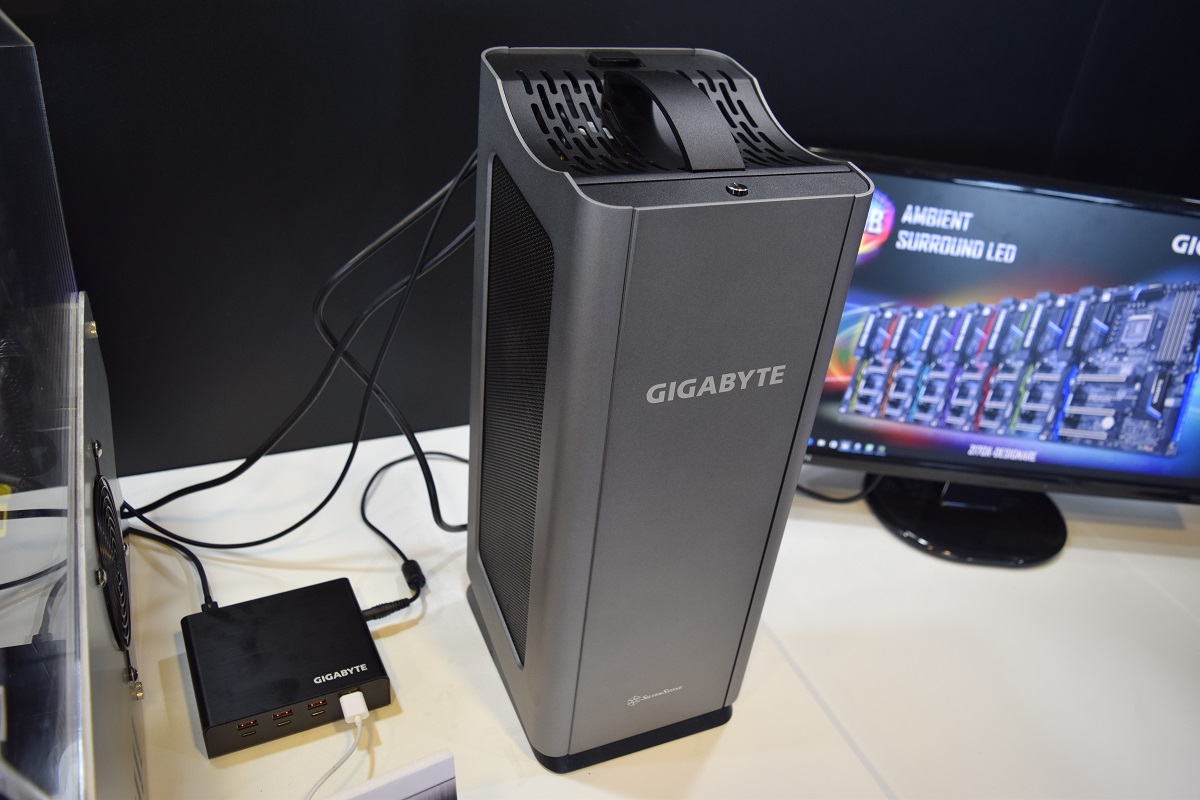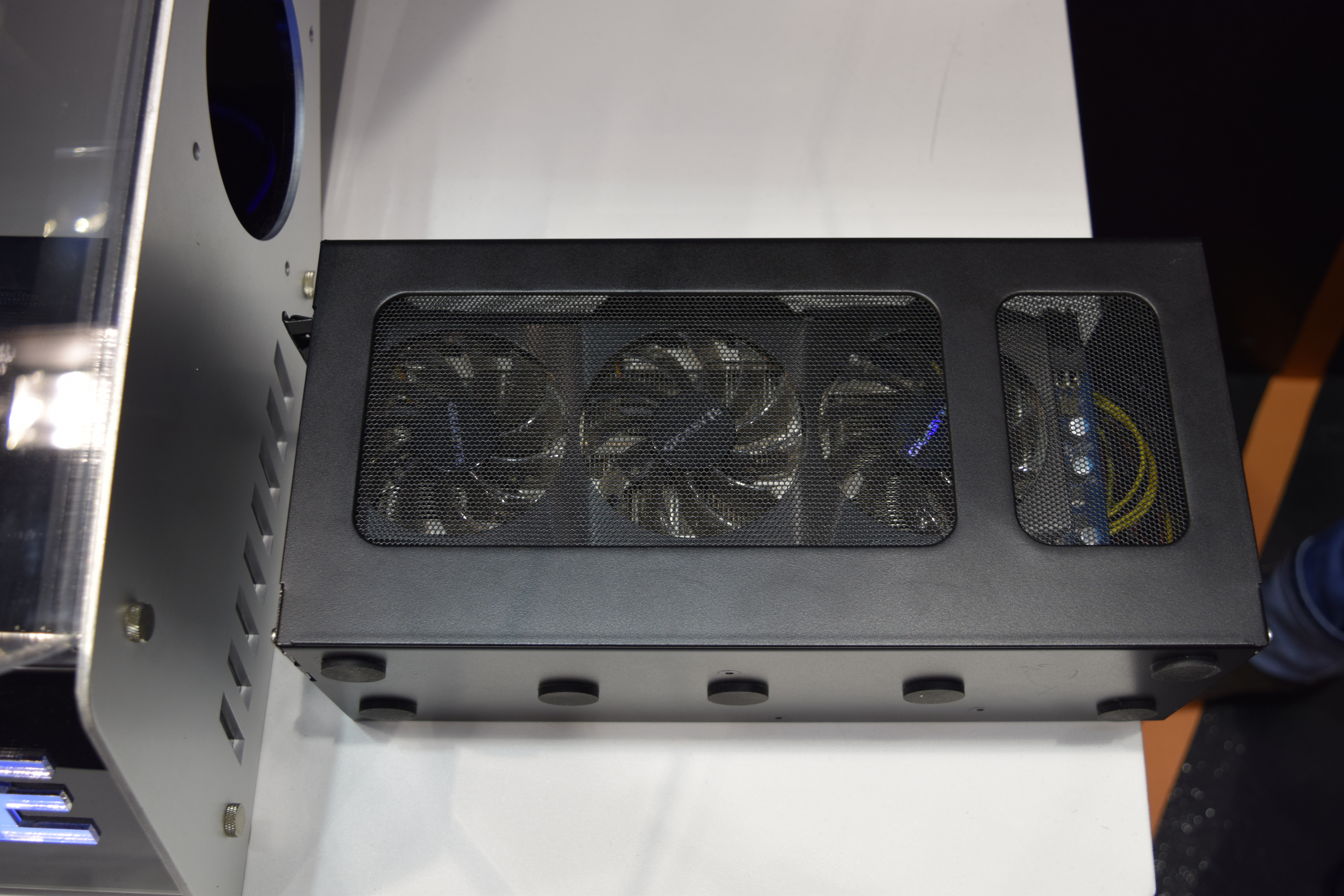Gigabyte's Got A GPU Dock, But It Is Early In Development
Gigabyte is preparing its entry into the external GPU dock market, but it is still early in development and we are unlikely to see a finished version in the near future.
This early version of Gigabyte’s GPU dock is fairly limited power wise compared to the ones from Asus, Powercolor and Razer. Although the GPU dock is roughly the same size as its would-be competitors, both Powercolor and Razer use 500W PSUs, while Gigabyte is using just a 250W power supply. It is even further behind the Asus ROG XG2, which has a beefy 680W PSU.
This means that Gigabyte's GPU dock cannot support GPUs that consume over 175W. Technically, you could attempt to run a GPU that needs more power than that, but to ensure stability at peak power consumption, it is best to stay 25 percent below the PSUs total power output.
Gigabyte is considering switching to a 350W PSU, which would open the dock up to GPUs that consume up to 262.5W on average. That should be plenty of power to run high-end GPUs like Nvidia's GTX 1080. It wouldn't completely resolve the problem, however, as devices connected to the GPU dock can absorb up to 100W over the USB Type-C port, but it is impossible to tell how serious the power issue is without testing the performance and efficiency of the PSU inside.
Similar to the Devil Box and the Razer Core, Gigabyte opted to use Thunderbolt 3 over a USB Type-C port, and it is designed to be compatible with essentially any PC with that supports these technologies.
The current prototype is a little different from the other external GPU docks we have seen in that it stands up instead of laying down on a flat surface (see photos above). This might be the finished case design, but it it also may change. We actually saw two versions of this GPU dock, but one of them was essentially a black rectangular box and certainly wasn’t a finished prototype.
Because the dock is still being developed, Gigabyte didn’t know how much it would cost or when it would be available. We likely won’t see a finished version for several months at the very least.
Get Tom's Hardware's best news and in-depth reviews, straight to your inbox.
Follow Michael Justin Allen Sexton @EmperorSunLao. Follow us on Facebook, Google+, RSS, Twitter and YouTube.
-
arossetti Are these even going to be necessary in a year? nVidia already announced the GTX 1080 is being dropped into laptops - albeit at a lower clock speed. That's more than enough GPU power for a gaming laptop in a year or two when Volta starts to roll out, I'm sure these things will be obsolete.Reply
Just seems to me that they solve a non-existent problem. -
Quixit ReplyAre these even going to be nesissary in a year? nVidia already announced the GTX 1080 is being dropped into laptops - albeit at a lower clock speed. That's more than enough GPU power for a gaming laptop in a year or two when Volta starts to roll out, I'm sure these things will be obsolete.
Just seems to me that they solve a non-existent problem.
A lot of people don't want to carry around giant brick-like laptop. These things make sense as long as that's still an issue and Volta isn't going to give you high-end performance in 15W. -
photonboy also, mobile gaming laptops are expensive. What we really need is a reasonably priced laptop with a suitable gaming CPU, and an inexpensive gaming dock.Reply
In USD, maybe $600 for the laptop, and $100 for the dock, plus something like an RX-480.
I'd like to see an APU + shared memory idea instead of just a GPU. Then the game would run completely on the external unit which has advantages.
I'd also like to see units that are designed to be external, so much smaller with a tiny PSU. You could make one for about the size of a 3.5" HDD USB enclosure that's really powerful. -
g-unit1111 Reply18072103 said:Are these even going to be necessary in a year? nVidia already announced the GTX 1080 is being dropped into laptops - albeit at a lower clock speed. That's more than enough GPU power for a gaming laptop in a year or two when Volta starts to roll out, I'm sure these things will be obsolete.
Just seems to me that they solve a non-existent problem.
Yeah between that and AMD's new mobile GPU platform, I'm wondering just how necessary these things are. One thing is for certain - they seem to defy the laws of what being portable truly means. -
erickmendes Look JUST like the XG2 from Asus/SilverStone... 2014 news:Reply
http://www.anandtech.com/show/7987/running-an-nvidia-gtx-780-ti-over-thunderbolt-2 -
arossetti Reply18078170 said:18072103 said:Are these even going to be necessary in a year? nVidia already announced the GTX 1080 is being dropped into laptops - albeit at a lower clock speed. That's more than enough GPU power for a gaming laptop in a year or two when Volta starts to roll out, I'm sure these things will be obsolete.
Just seems to me that they solve a non-existent problem.
Yeah between that and AMD's new mobile GPU platform, I'm wondering just how necessary these things are. One thing is for certain - they seem to defy the laws of what being portable truly means.
That's pretty much my point. If I want a gaming laptop I want it for the portability as well as the GPU power. Otherwise I'll keep my powerful desktop, large screen monitor, and take a notebook or iPad with me while I'm on the go. -
ET3D I'm a little late to comment (I occasionally search for eGPU news, which is why I only saw it now), but in a sense I agree with arossetti. These eGPU cases are huge and cost as much as a PC. Might as well buy a good HTPC for the same price and the same size.Reply
What I really want are external HD style GPU's, small specially designed cases with small GPU's. They don't need to be high end GPU's, something like an RX 460 will be fine. They just need to be significantly faster than integrated graphics, portable and don't cost too much. I think I won't mind paying $200 for the equivalent of a $100 PC card, but I don't want to pay $500. -
kinney These things are going to become more popular over time, not less. Desktop sales in general are plummeting and will continue to do so. GPU cases unify the (growing, healthy) laptop market and growing NUC market.Reply
Few examples how these can be used:
1. You can share 1 expensive GPU between multiple family laptops and a NUC at 1 desk rather than outfit 4 people with Geforce 1080s.
2. It's also great for say a college kid, you need a laptop for school and maybe you want to play games in your dorm but don't want some massively expensive huge gaming laptop? You get a Thunderbolt GPU case.
3. Someone who travels for work, needs a laptop but again just wants the top-end hardware at home rather than continuously buying the latest $2000 gaming laptop every year.
It just makes a lot of sense with no real negatives other than price, which will drop. It's still early days. Wait till Rosewill sells one that's just a case + TB3 interface, and you provide your own ATX power supply of choice.
That will be the tipping point for this market. People just need a while to get used to the idea, but GPU cases, NUCs and laptops are the future.

